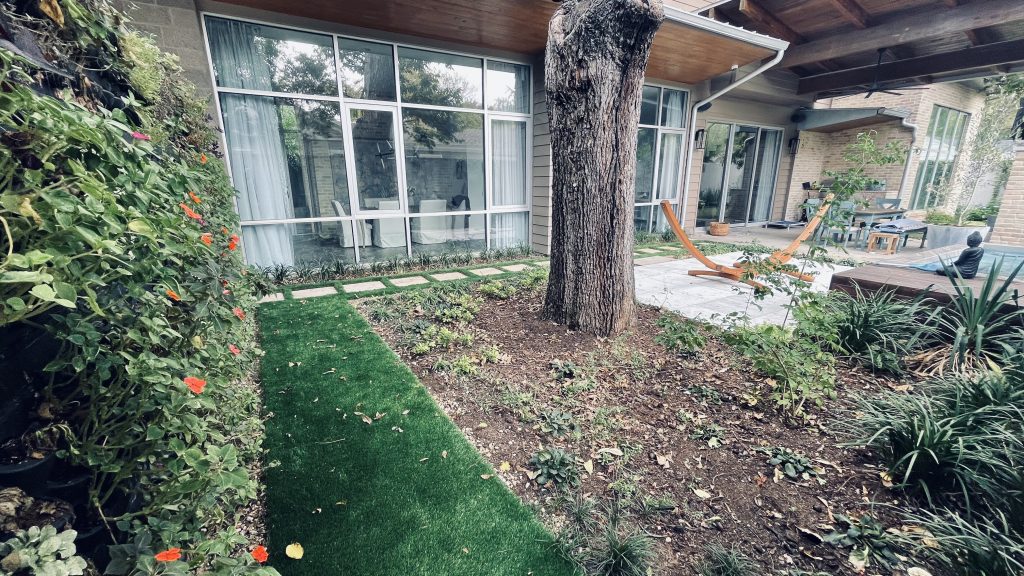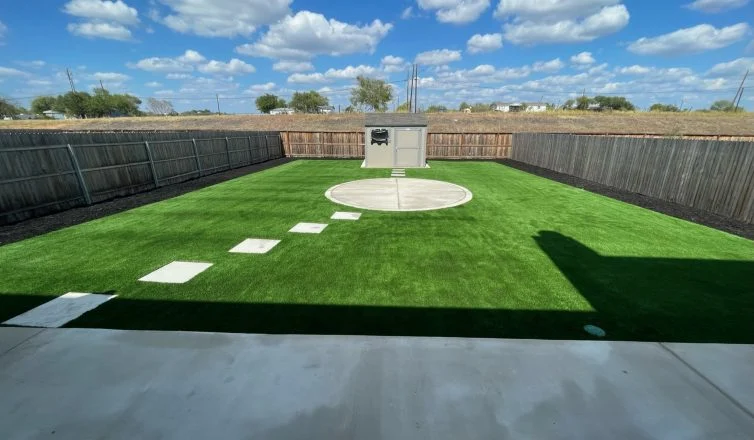Have you ever wondered whether your artificial grass can really handle everything Mother Nature throws at it? Maybe you’re concerned that the sizzling Southern sun will fade or scorch your turf, or you’ve worried about soggy patches after a downpour. You might even be curious about what happens to the fibers when winter brings a sudden cold snap. The good news? With a little seasonal know-how, artificial turf care is easier than you think. In this guide, you’ll discover straightforward tips to keep your lawn looking its best—no matter the season or the weather.
Quick Summary – Key Takeaways
- Simple, seasonal routines keep artificial turf looking great year-round.
- Summer: Brush and rinse your turf to prevent matting and odors. Use shade when possible during heat waves.
- Rainy season: Quickly remove debris and check for mold. Drying happens fast, but post-storm cleanup keeps turf fresh.
- Winter: Most turf is freeze-resistant, but gently clear snow or ice when needed. Avoid metal shovels.
- Monthly basics: Spot-clean pet areas, brush high-traffic zones, and look for loose seams.
- When in doubt: Call a professional for stubborn stains or repairs.
- View our Ultimate Guide to Artificial Turf for expert checklists and product tips!
Why Seasonal Artificial Turf Care Matters
While artificial turf is built to last, giving it a little extra attention during weather extremes keeps it looking real and feeling soft underfoot. The payoff is better curb appeal, a longer-lasting investment, and more time to enjoy your outdoor space—with less work.
Artificial Turf Care in the Summer Heat
How Heat Affects Artificial Turf
Artificial turf is tough, but summer heat can push the surface temperatures higher than natural grass. Prolonged exposure to strong sun can also affect color and create a risk of melting if reflective surfaces are nearby.
Top Tips for Turf in the Hottest Months
- Brush regularly: Keeps fibers upright and prevents matting from heavy foot traffic or play.
- Rinse with water: A quick hose-down removes dust or pollen and cools the surface (especially when specialty cooling infill is installed).
- Shade when possible: Use umbrellas or pop-up canopies during outdoor gatherings to provide relief for people and turf alike.
- Watch for reflective heat: Move items like mirrored windows or shiny grills that can focus sunlight and damage the turf.
- Combat pet odors: Use a turf-safe enzyme cleaner in spots that pets frequent to eliminate smells.
Common Summer Myths (and the Truth)
Myth: Turf turns brown in summer.
Fact: Quality artificial turf is UV-stabilized and keeps its green color, even in the heat and direct sunlight.
Myth: Turf isn’t safe for bare feet in summer.
Fact: It can feel warm on extra-hot days. A quick rinse or use of shade makes it comfortable again.
Artificial Turf Care During Heavy Rain
How Rain Impacts Artificial Turf
Modern artificial turf is designed to handle wet conditions and dries quickly. However, heavy rain can temporarily flatten blades and leave organic debris behind.
Simple Steps for the Rainy Season
- Remove leaves and debris: Prevent buildup by using a leaf blower or garden broom after a storm.
- Check for mold: Damp spots can, on rare occasions, lead to mildew if organic matter is left behind. A mild vinegar solution can help prevent or treat it.
- Give pets a dry space: Place a mat at entry/exit points for your dogs to shake off before heading indoors.
- Let it air out: Most turf rebounds naturally as it dries without a need for special tools.
Solving Common Rain-Related Concerns
Myth: Artificial turf will flood or stay soggy after heavy rain.
Fact: Modern artificial turf is designed to dry quickly after storms, so soggy grass is rarely a problem. Any pooled water usually evaporates or drains away fast.
Myth: You need to do a lot of maintenance after every rain.
Fact: Basic cleanup—removing leaves and debris—after a storm is usually all it takes to keep turf looking its best.
Artificial Turf Care in Snow and Freezing Weather
Can Artificial Turf Handle Snow?
Yes. Artificial turf stands up well to occasional snow and frost, even in Southern climates. The fibers are designed to bend and bounce back.
Winter-Proof Maintenance Tips
- Brush off light snow: Use a soft-bristled broom to gently sweep away light snow or frost.
- Avoid metal tools: Shovels and rakes with metal edges can damage turf. Stick to plastic or rubber for snow removal.
- Let ice melt naturally: No need to use harsh chemicals or salt. Just let the sun and air do the job.
- Prep before freezes: Give turf a quick clean before a major freeze to prevent leaves or debris from getting trapped.
Myths About Turf and Winter Weather
Myth: Turf will crack or split in cold.
Fact: Quality turf is flexible and made to withstand seasonal swings in temperature.
Myth: Snow and ice will permanently flatten artificial turf.
Fact: Turf fibers are designed to bounce back after snow compacts them. Once the ice and snow melt, a quick brush will help restore the turf’s natural look.

Year-Round Artificial Turf Care Essentials
Monthly and Quarterly Must-Dos
- Rinse pet areas and high-traffic spots: A quick water spray keeps surfaces clean and odor-free.
- Brush up matted blades: Use a stiff brush to revive the “freshly mowed” look.
- Inspect seams and edges: Catch issues early before they require bigger repairs.
Pet Turf Care Basics
- Spot-clean messes quickly: Remove solids and rinse liquid spots as soon as possible.
- Use odor-control products: Enzyme sprays are safe and effective for neutralizing tough smells.
- Keep it fresh: Let turf dry fully between uses, especially after cleaning.
Troubleshooting & Pro Tips
Quick Fixes for Common Turf Issues
- Tough stains: Use a diluted vinegar solution or mild soap and water. Avoid bleach.
- Sticky residue (gum, sap): Freeze with an ice cube, then gently scrape off with a plastic tool.
- Burn marks (from hot objects or reflective surfaces): Minor spots can sometimes be trimmed or worked out. Call a pro if you see extensive damage.
When to Call a Pro
- Large rips or tears
- Loose or lifting seams
- Stubborn or recurring stains
Tools and Products We Recommend
- Turf-safe enzyme cleaners
- Soft-bristled brooms/brushes
- Pet mats for entries/exits
- Plastic snow shovels (for rare snows)
FAQ—Your Artificial Turf Care Questions Answered
Q: What is the best way to clean artificial turf after pets use it?
A: Remove solid waste promptly, rinse with water, and use a turf-safe enzyme cleaner for lingering odors. For regular maintenance, a quick hose-down does the trick.
Q: Do I need to water my artificial turf?
A: You don’t need to water for growth, but a rinse now and then keeps it clean and cools the surface during hot weather.
Q: How can I prevent mold or mildew on my turf?
A: Keep turf free of leaves and organic debris, and let it dry out between storms or hose-downs. If you notice any spots, clean with a mild vinegar solution.
Q: Is artificial turf safe during extreme heat or cold?
A: Yes—quality turf is made for all weather. It can get hot on the surface in direct summer sunlight, but doesn’t fade or crack. In winter, it stays flexible and bounces back after frost.
Q: Do I need special tools for artificial turf care?
A: Not really—a garden hose, soft broom, and pet-friendly cleaner are usually all you need. Avoid metal tools for snow or tough stains.
Q: How often should I perform artificial turf maintenance?
A: Light upkeep (like brushing or rinsing) once a month, and a more thorough cleaning each season will keep your turf looking great. Pet owners may need to spot-clean more often.
Year-Round Turf Confidence Starts Here
Keeping your artificial lawn looking fresh isn’t complicated—it just takes a little seasonal attention and a few simple habits. By following these artificial turf care tips, you’ll enjoy a yard that stays green, clean, and ready for fun, no matter the forecast.
Ready to master every season? Download our free Buyer’s Guide to Artificial Turf for more expert advice and insider maintenance tips. Have questions or want extra support? Drop a comment below—we’re always here to help!
